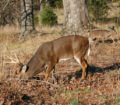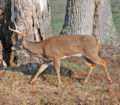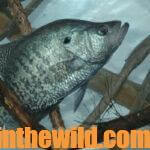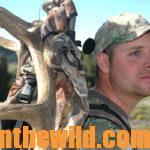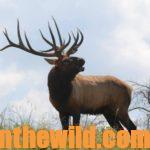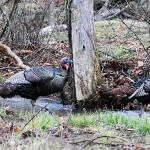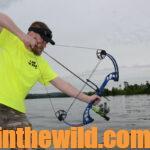Editor’s Note: If you put deer attractants along the edges of trails that deer use every day, they don’t have to find the attractants but will pass by them regularly. You’ll see more deer at your deer attractant sites next to trails, than if you just put an attractant out in the middle of the woods where there’s no deer sign at all.
 Hunting the buck as he goes to his bed presents another hunting opportunity. In most areas, when deer are being pressured, they will move to their beds just at daylight. By locating a buck’s food source and where he beds, you can place your stand and climb in it before daylight. Mike Fine, a friend and an avid deer hunter, emphasizes that, “I get as close to a bedding area as I can without disturbing the deer, so I have the most light. I hunt farther off the trails than most people I know and always on the downwind side. One of the mistakes people make is hunting too close to where they anticipate their shots. I primarily enjoy bowhunting, and usually bowhunters practice at distances of 30 yards or so. Then they try to set-up a closer shot at a closer range when they’re actually in the woods where the deer’s ability to detect them is much greater.”
Hunting the buck as he goes to his bed presents another hunting opportunity. In most areas, when deer are being pressured, they will move to their beds just at daylight. By locating a buck’s food source and where he beds, you can place your stand and climb in it before daylight. Mike Fine, a friend and an avid deer hunter, emphasizes that, “I get as close to a bedding area as I can without disturbing the deer, so I have the most light. I hunt farther off the trails than most people I know and always on the downwind side. One of the mistakes people make is hunting too close to where they anticipate their shots. I primarily enjoy bowhunting, and usually bowhunters practice at distances of 30 yards or so. Then they try to set-up a closer shot at a closer range when they’re actually in the woods where the deer’s ability to detect them is much greater.”
In scouting a bedding region, you should spend as little time as possible to determine where to put your tree stand, because as Fine observes, “Deer won’t feel secure in a bedding area, if they detect human odor. Always scout bedding sites in advance of deer season before the bucks become sensitive to human sightings and smell. Also, I don’t cross any bedding trails, if I can avoid them, and will go out of my way to not cross them.”
Bedding areas are one of the best places to use a deer attractant. However, as Fine states, the chances of spooking a deer in a bedding area are very high. “If possible, get close to the bedding area as quietly and as scent-free as you can on a day when the wind’s blowing from the bedding site toward you. The stronger the wind, the better the odds that you won’t spook the deer you’re trying to take. Once you’re close to the bedding region, then with the wind in your face, put-out a deer attractant no more than one or two steps from that thick-cover area. A buck doesn’t want to come out of his bedding area during daylight hours. So, the shorter the distance the buck has to travel from his bedding area to get whatever he wants – food, water or sex – the more likely you are to lure him out of his bedding area.”
 If you’ll put-out a deer attractant, so the buck only has to have about half of his body exposed to get the attractant, your chances of being able to see or take him are much greater. This tactic is far-more risky for a bowhunter than a gun hunter. A gun hunter can use this tactic and stay 50- to 100-yards away from a bedding site in a tree with a prevailing wind. But a bowhunter has to get close to that bedding area. Unless he’s totally scent-free, if the wind changes, he runs the risk of having the deer smell him before the deer smells the deer attractant. Bowhunters can use this tactic, but they must know or hope that they have the same wind direction all day when they’ll be hunting this site. Too, they must know that the wind won’t carry their human odor into the bedding area.
If you’ll put-out a deer attractant, so the buck only has to have about half of his body exposed to get the attractant, your chances of being able to see or take him are much greater. This tactic is far-more risky for a bowhunter than a gun hunter. A gun hunter can use this tactic and stay 50- to 100-yards away from a bedding site in a tree with a prevailing wind. But a bowhunter has to get close to that bedding area. Unless he’s totally scent-free, if the wind changes, he runs the risk of having the deer smell him before the deer smells the deer attractant. Bowhunters can use this tactic, but they must know or hope that they have the same wind direction all day when they’ll be hunting this site. Too, they must know that the wind won’t carry their human odor into the bedding area.
The late Clarence Yates, who took more than 100 deer with his bow, once said, “You should never hunt a deer’s bedding area when the wind’s blowing in the wrong direction. If you’re hunting next to lowlands, remember that air usually will move from higher elevations to the lower part of a hollow in the evenings. So, set-up on the lower side of the trail going to and from where the deer’s bedding. If you plan to hunt a bedding trail in the morning, don’t forget that, because air rises at that time, you should place your tree stand on the upper side of the trail. If I can’t reach a bedding site well before daylight and be on my stand with a favorable wind direction, then I hunt another place that day. I’ve learned that if I spook a buck coming to his bed, more than likely that’s the last time I’ll see that animal during the season.”

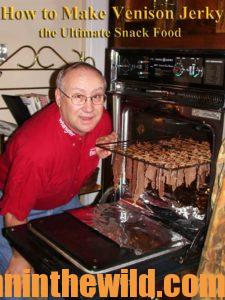 To learn more about hunting deer, go to John E. Phillips’s book, “How to Hunt Deer Up Close with Bows, Muzzleloaders and Crossbows” https://www.amazon.com/dp/B00A2A6ZG6#. To receive your free book on “How to Make Venison Jerky,” go to https://www.emailmeform.com/builder/form/Ece3UZVcOo52cKPJcL.
To learn more about hunting deer, go to John E. Phillips’s book, “How to Hunt Deer Up Close with Bows, Muzzleloaders and Crossbows” https://www.amazon.com/dp/B00A2A6ZG6#. To receive your free book on “How to Make Venison Jerky,” go to https://www.emailmeform.com/builder/form/Ece3UZVcOo52cKPJcL.

